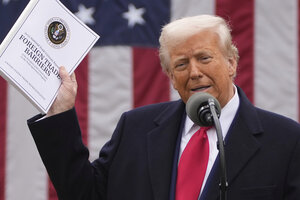Of all the extraordinary images from President Donald Trump’s whirlwind return to office, one might capture the ethos best: Elon Musk wielding a chain saw.
The ultra-wealthy Mr. Musk – spearheading President Trump’s drive to slash government – waved a totem of his effort before cheering conservatives at the annual Conservative Political Action Conference two months ago.
For Mr. Trump, the scene also signified an evolution from his first term: Let another outsize character occupy the spotlight, at times, to serve the president’s larger goals – and possibly absorb blame if things go terribly wrong.
Why We Wrote This
The blistering start to President Donald Trump’s second term has put plenty on the line. Turmoil over tariffs has upended global markets. Deportations are testing the boundaries of presidential authority. Federal agencies have been radically downsized. A lesson Mr. Trump seems to have learned from his first term is to be more aggressive in pursuit of his goals.
There’s plenty on the line after 100 disruption-filled days of Trump 2.0: Turmoil over tariffs has upended global markets and threatened the world economy. An aggressive push to deport unauthorized immigrants is testing the legal boundaries of presidential authority. Federal agencies have been shuttered or downsized. America’s role as leader of the free world appears in jeopardy. And at home, efforts to rein in diversity, equity, and inclusion programs and “woke” culture have roiled academia and the arts.
Mr. Trump has even suggested he might go for a third term – in direct defiance of the 22nd Amendment to the Constitution.
The blistering start to Mr. Trump’s second term may be the most consequential since 1933, when President Franklin Delano Roosevelt swept into office amid the Great Depression and immediately set about addressing the crisis. But there are big differences between the two.
While President Roosevelt benefited from large Democratic majorities in Congress, which codified many of his sweeping initiatives, Mr. Trump faces a deeply polarized Congress with slim Republican majorities – and most of his actions have been done without lawmakers.

Elon Musk holds up a chainsaw he received from Argentina’s President Javier Milei (right) at the Conservative Political Action Conference, or CPAC, at the Gaylord National Resort & Convention Center, Feb. 20, 2025, in Oxon Hill, Maryland.
In his first 100 days, FDR issued a record 99 executive orders and signed major legislation aimed at alleviating widespread poverty and reviving the economy. Mr. Trump has blown past Mr. Roosevelt’s record for executive orders, signing 139 through April 25. They range in import from directing the military to seal the borders against “invasion,” to fighting ticket scalping and paper straws.
Meanwhile, the Trump legislative record is meager. Congress has passed (and the president has signed) just five bills thus far, a record low for the first 100 days of any presidency.
The impact of this disparity could be profound. Legislation is typically more enduring, while executive orders are more easily undone by the next president. Though with a bit under 45 months to go in Mr. Trump’s second term, the orders he’s issuing now have a long time to become part of the national fabric.
The other potential impact centers on next year’s midterm elections. Executive orders that inflame and galvanize the opposition could help Democrats retake at least one house of Congress, making it well nigh impossible for Mr. Trump to pass anything in his final two years.
Historically, Mr. Trump is a rarity – only the second U.S. president ever to win nonconsecutive terms. His four years out of office, during the Biden interregnum, gave him time to plan for his return and hit the ground running on Day One. And this time around, he had a much better understanding of the job and what he could do with it.
“Most presidents leave their first term in awe of their own power,” says Jeffrey Engel, director of the Center for Presidential History at Southern Methodist University in Dallas. “He had four years to think about it.”

Attorneys from the Education Department’s General Counsel Office are greeted by supporters outside the building in Washington, March 24, 2025. The Education Department workforce was reduced by half.
The main lesson Mr. Trump seems to have learned from his first term, Professor Engel adds, was to be more aggressive in pursuit of his goals – “push everything off a cliff, and pick up the pieces that remain.”
The sharpest example may be Mr. Musk’s so-called Department of Government Efficiency, or DOGE. With an original goal of eliminating $2 trillion in federal spending, or almost 30% of the budget, Mr. Musk recently revised his savings estimate to just $160 billion. Still, the CEO of Tesla and SpaceX brought a “move fast and break things” approach from the tech world to the federal bureaucracy – sparking controversy among the public and even within the Trump cabinet. Polls show him to be increasingly unpopular.
On the two main issues that helped hand Mr. Trump a second term, the president’s pursuit of big changes is proving even more polarizing.
“There’s not a sophisticated ideology there or well thought-out doctrine, but he’s got visceral commitments to two things: immigration and tariffs,” says Sidney Milkis, a political scientist at the University of Virginia.
Add to that a third component: fighting cultural liberalism, including DEI and trans rights. “Trump wants to own the ‘libs’ and take on these ‘wokes,’” Professor Milkis says.
Trump 2.0’s opening act has also included its share of unplanned disruption, most prominently within his national security team. Defense Secretary Pete Hegseth appears on thin ice, following the “Signalgate” scandal, in which a journalist was inadvertently included in a group chat over U.S. military attack plans, and widespread reports of disarray in Secretary Hegseth’s office.

Members of the U.S. Army 212 Infantry 2nd Brigade stand next to the U.S.-Mexico border wall, as part of Joint Task Force Southern Border, April 3, 2025, in Douglas, Arizona.
By many accounts, Mr. Trump doesn’t want to fire high-profile officials so early in the new term. In his first term, he fired National Security Adviser Michael Flynn just 22 days in, a move he soon regretted. Mr. Trump has filled his cabinet with loyalists this time around, after finding himself at odds with some of his own advisers during his first term.
As the 100-day mark of Term Two approached, polls showed Mr. Trump losing altitude with voters. After beginning above 50% public job approval, by April 25 he stood at 45%, with disapproval at 52%, according to the Real Clear Politics polling average. He fares worse on the economy (42% approve, 55% disapprove) and better on immigration (48% approve, 49% disapprove).
Those were the two most important issues for voters last November, and will be most likely to shape next year’s midterm elections. But other matters remain consequential. Here’s how the top issues have played out during Mr. Trump’s tumultuous first 100 days:
“Liberation Day” and beyond
Before last November’s election, The Economist magazine declared the U.S. economy “the envy of the world.” But to many Americans, the cost of living was – and still is – unaffordable. While pandemic-fueled inflation has cooled, prices remain elevated. Exit polls showed that 75% of voters said inflation had caused hardship over the past year – and voters believed Mr. Trump would be more likely to bring prices down than his Democratic opponent, then-Vice President Kamala Harris.
Enter tariffs. For decades, Mr. Trump has decried the global trade system as unfair, and supported tariffs on imports as a way to address trade deficits with countries he said were “ripping the U.S. off.” In his first term, he introduced higher tariffs on some countries, most prominently China.
But on April 2, which he dubbed “Liberation Day,” Mr. Trump announced blanket tariffs on nearly every trading partner, some severe. Global markets have been on a roller coaster ever since, recovering somewhat only after the president implemented a 90-day “pause” for most countries, although not China. Economists predict that businesses will pass the cost of tariffs on to consumers, sparking inflation, but Mr. Trump says the money will come back to consumers in the form of potential tax cuts from Congress.

President Trump announces sweeping new tariffs in the Rose Garden at the White House, on April 2, 2025, a day he dubbed “Liberation Day,” in Washington.
Tariffs on China, a major source of U.S. imports, now stand at 145%. Cargo shipments have plummeted, though most Americans have yet to feel the impact on prices. Some analysts see the president’s tariffs as a play for leverage, not an end goal. But as of April 27, it was unclear if trade negotiations had even started.
When the pause was announced April 9, the Trump team forecast “90 deals in 90 days.” In a Time magazine interview last week, Mr. Trump said he’d already negotiated 200 deals, which would be announced in “three to four weeks.” Chinese officials say they have not yet spoken to the U.S. president.
Another source of economic uncertainty centers on Federal Reserve Chair Jay Powell and his handling of interest rates. Mr. Trump wants rates lower, but is legally barred from firing the Fed chair. Last week, the president said he had “no intention” of ousting Mr. Powell. But he has set up Chair Powell for blame if the economy goes south.
Immigration: A whole-of-government effort
President Trump is harnessing his whole government for immigration enforcement. In doing so, he has stress-tested the limits of executive power in unprecedented ways.
On Day One, Mr. Trump declared a national emergency at the Southern border, and he has directed a military surge there. Citing an “invasion” of criminals, he pushed to end illegal entry and bar access to asylum, a protection outlined in U.S. law that many officials say was being abused as a way to enter without valid claims. Border Patrol encounters at the southern border, a proxy for illegal crossings, fell just below 7,200 in March – down 95% from the same month last year.
Not only is the administration targeting unauthorized immigrants, it’s also going after people who’d been given temporary permission to work or study in the United States. By enforcing old or rarely used laws, Mr. Trump is expanding the scope of who can be deported. He has also moved to suspend the admittance of refugees, people who’ve been vetted and approved for protection in the U.S.

Detainees exercise in the courtyard of the Bluebonnet Detention Facility, where Venezuelans targeted for deportation by the Trump administration are being held, in Anson, Texas, April 28, 2025. The Supreme Court has temporarily blocked the deportations.
A torrent of litigation against Mr. Trump’s immigration agenda has already reached the Supreme Court. The justices have placed limits on his attempts to deport Venezuelans as “alien enemies” under an 18th-century wartime law. They’ve also asked the administration to facilitate the return of the wrongfully deported Kilmar Ábrego García, a Maryland resident whom the government sent to El Salvador and has accused of being an MS-13 gang member.
Critics say the White House is already flouting court orders, pointing to a constitutional crisis. Trump officials counter that judges have overstepped in checking the rightful power of the executive as they rein in mass-deportation plans. Ultimately, Congress will decide how much of this agenda it’s willing to fund. (Capitol Hill has given Mr. Trump one new immigration law so far, a feat not seen in years.)
Next month, the Supreme Court will hear arguments on Mr. Trump’s attempt to limit a constitutional right: birthright citizenship.
You’ve been “DOGED”
It began as a meme, then an outside commission, and finally a quasi-government department that, in whirlwind fashion, aimed to cut waste, fraud, and abuse in the federal government.
So far, DOGE’s impact has been considerable, starting with the more than 121,000 federal workers who have lost their jobs since Mr. Trump retook office, according to a CNN analysis. And that’s not including those placed on administrative leave or who took a buyout.
But the savings to government are projected to be far below the $2 trillion originally promised by Mr. Musk. Over time, he dialed back planned cuts first to $1 trillion, and more recently to $160 billion, out of a total federal budget of $6.8 trillion.
Last week, Mr. Musk announced he would “significantly” reduce his time working on DOGE beginning in May, and refocus on his businesses. The news came on a Tesla earnings call, which reported a 20% drop in sales of electric cars, year over year, and a 71% drop in profits.

Employees of the United States Agency for International Development (USAID) carry their personal belongings out of the agency’s headquarters in Washington, Feb. 27, 2025. USAID, which distributed foreign aid, was almost entirely eliminated.
During Mr. Musk’s time as a special presidential adviser, the billionaire entrepreneur’s popularity among U.S. adults has declined from 41% last December to 33% in April, according to an AP-NORC poll.
Even if DOGE fades from the spotlight, its impact is likely to live on. Numerous government agencies have been downsized or eliminated outright. The U.S. Agency for International Development and Voice of America, institutions of American “soft power” overseas, have both been shuttered, though legal challenges are pending.
Still, DOGE may not ultimately have as big an impact as the last major government reform effort, under Vice President Al Gore, which began with a six-month review and lasted five years, from 1993 to 1998. The federal workforce was reduced by more than 250,000 people, and saved taxpayers $136 billion.
A new administration could also wind up restoring some of the eliminated agencies. Max Stier, CEO of the Partnership for Public Service, says that could happen relatively quickly, because “there’s a deep well of purpose in the federal workforce and the American people.”
War and peace, Canada and Greenland
Mr. Trump’s slogan “America First” brings to mind a return to isolationism and an end to the post-World War II order. Proposed cuts to the State Department include a reduction in U.S. diplomatic missions abroad, ceding ground to China’s growing international presence.
But Mr. Trump isn’t giving up on his own potential as a peacemaker. Before retaking office, he boasted he could end Russia’s war in Ukraine in one day. Closing in on his 100th day back, he conceded privately that brokering a deal was easier said than done.
Still, the image of Mr. Trump sitting down, one on one, with Ukrainian President Volodymyr Zelenskyy in Rome before Pope Francis’s funeral Saturday offered hope for a way forward. It was their first meeting since their disastrous Oval Office encounter in February.
In the Middle East, too, Mr. Trump sees himself as a player in helping to resolve the Israel-Gaza war, even if his musings about turning Gaza into the “Riviera of the Middle East” were met with derision. His envoy’s effort to strike a nuclear weapons deal with Iran shows, again, that Mr. Trump does see a role for the U.S. on the world stage.

Vice President JD Vance and second lady Usha Vance listen to Col. Susan Meyers as they tour the U.S. military’s Pituffik Space Base in Greenland, March 28, 2025. President Trump has repeatedly said he would like the semi-autonomous Danish territory to become part of the U.S.
Then there are Canada and Greenland – one a sovereign nation, the other a territory of Denmark, both of which Mr. Trump has mused about annexing. Such imperial designs are a second-term phenomenon and apparently not a joke. On Monday, as Canadians went to the polls, Mr. Trump posted on social media yet again that “Canada should become our Cherished 51st State.” It may reflect his admiration for President William McKinley, known for building the “American empire” by his acquisition of Hawaii, Guam, the Philippines, and Puerto Rico.
A cultural revolution
Mr. Trump’s “anti-woke” crusade is another feature of the second term that had no precedent in the first. Within hours of retaking office, he signed an order eliminating all DEI offices from the federal government – a rebuke of former President Joe Biden’s efforts to promote diversity, equity, and inclusion.
In Mr. Trump’s view, DEI is discriminatory. Government contracts focused on DEI initiatives have been canceled, too. Another presidential order on Jan. 20 made it “the policy of the United States to recognize two sexes, male and female.”
The Trump administration’s action against universities, withholding or canceling research grants over alleged antisemitism, DEI, and gender policies, is another front in the burgeoning culture war. Some schools have capitulated, but others, including Harvard University, are fighting back.
In Washington, another stark example of the Trump-era cultural shift came in February, when the president took control of the John F. Kennedy Center for the Performing Arts. Such a move was not on anyone’s radar during his first term, or in his two reelection campaigns.
But Mr. Trump did it, in part, because he could. Professor Milkis calls it a sign of growing “presidentialism,” including a reliance on executive action, not laws, to govern.
Now, each night, the Kennedy Center is lit up in red, white, and blue – “a reminder of the American spirit,” a center official writes – and perhaps, too, of Mr. Trump himself.
Staff writer Caitlin Babcock contributed to this report.


